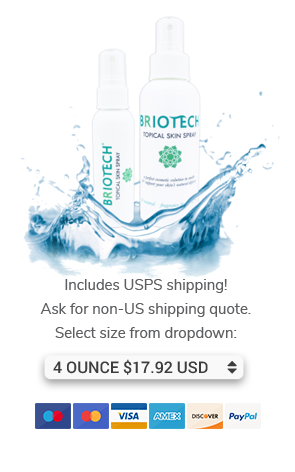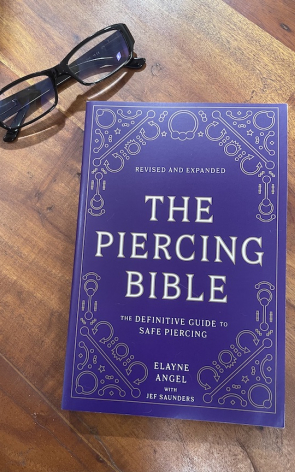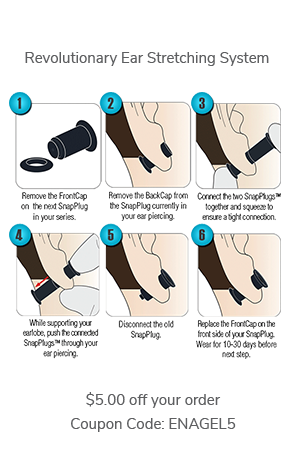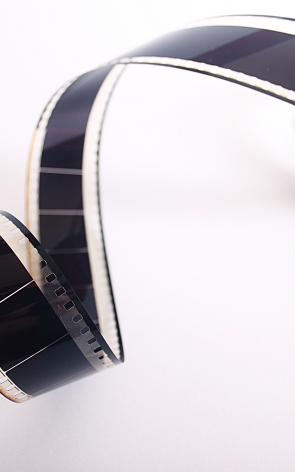Hello Elayne,
I would really love to have your opinion and thoughts on my "future piercings". I have been contemplating a new piercing for quite some time now. I am thinking about getting four Micro Dermal Anchors on my chest. I will enclose a link/image to the exact placement of the dermals at the end of my message. I stumbled across your wonderful website after doing a lot of endless research. I think that it's awesome that you actually take the time to respond to all of us who message you in need of help or wanting questions answered ! Please forgive me as I have a few loaded questions for you ! I also wanted to say that after much investigation there is literally (or almost) next to no one in the state of North Carolina that I would remotely trust to do these piercings. After cross referencing with the Association of Professional Piercers and lots of thought, I have chosen to travel almost six hours to Immaculate Body Piercing of Columbia, SC. To my delight, I have just learned they are also on your list of Piercer Referrals!(Yay!).
I apologize ahead of time for this being so long. Sorry!
1. My main concern is the fact that due to my medical condition (Intracranial Hypertension) there is a possibility that I will need an MRI (Location:Brain) within the next year and a half. From what I have gathered on the internet, Anatometal and Industrial Strength are reputable companies for purchasing implant-grade titanium (MRI Compatible, as I refer to it) Micro Dermal Anchors. Immaculate Body Piercing has also confirmed with me that they also carry pieces from both companies, and can custom order from either at no extra charge. What do you think as far as the MRI goes? I really want this piercing and a lot of piercee's on online forums have said that they have had successful MRI's so long as they provided proof of authenticity or something called Mills? What are your thoughts? I am awaiting reply from Anatometal on if they can provide some type of authenticity that I could furnish to my Medical Providers. Due to distance, I am also awaiting reply via email from Immaculate Body Piercing to start our online consultation. I'm not trying to be selfish, I know my health is much more important than the piercings and the precautions are in place for my safety as well as for their liability, but I would really like to get these piercings for my birthday and not have to wait a year and a half to find out if I am even going to need another MRI or not. Especially if I can prove to my doctors that my jewelry is compatible and not from some flea market down the street.
2. I hope you are able to see the picture, I think I'll post a few of the same girl just in case. I can't tell if the piercings are indeed Micro Dermal Anchors or actual Surface Bars. I'm not sure if your able to tell either, but based on the placement, do you have a suggestion as to which method would produce a better result? From what I've been learning thus far, I am leaning towards Micro Dermal Anchors. I am definitely open to your thoughts.
3. On another note based on the placement, my breasts are a bit larger than hers. I am currently a D/DD depending upon the bra. I think the DD comes in to play more so from having such a large ribcage rather than actually having large breasts, if your asking for my opinion :). Nonetheless, Do you think that my size will negatively affect the overall outcome of the piercing? I would post a picture of myself, but I hope you understand that I would like to remain anonymous. Also, as a part of treatment for my condition I have been advised to lose weight. I have been doing so at a good pace, neither too fast nor too slow. I am wondering if weight loss will cause the Micro Dermal Anchors or Surface Bars (if you recommend them) to move or migrate or generally end up bad? Overall I am looking to lose about thirty to forty pounds over the next year or so.
Again, My apologies for rambling and generally sending you a giant email.
If you are able to reply, I want to thank you in advance! You are so thorough and detailed and I am truly excited to hear back from you!Sincerely, F. [We don't have permission to use the image, so I can't post it--sorry.]
Thanks for your message.
From what I could see in the photo, it appeared that she may have been wearing regular curved bars, which are not suggested for such a placement.
In all honesty, my best suggestion is that you consult with Sarah at Immaculate Body Piercing. There's some chance we have differences in our perspectives, policies, or preferences. Since she is the one piercing you, it is perhaps more important that you get feedback and input from her. I'm happy to share what information I have, but ultimately it is up to you and Sarah. And you should definitely have a good chat with her (via email or phone) before making the drive to see her.
You will want to share your medical history with her as well. I've read "Blood-clotting abnormalities have been documented in a number of women with chronic idiopathic intracranial hypertension." So that could be of concern with piercing. I actually requested additional information from that site as to any added risks of piercing on an individual with your condition.
Also, if you're planning on that much weight loss, there is a chance it could impact the outcome. So do bring this up with Sarah too. In addition to size of the area, I've found the pliability of the tissue an affect success. Weight loss could result in more pliability to the skin, which could help in the future--and may make postponing reasonable.
You might be able to get the mill certificates (the "mills" you mentioned) from Sarah. Did you ask her about that? Neither Anatometal or Industrial Strength jewelry should be any problem at all for an MRI. I had a cranial MRI with 27 pieces of quality body jewelry in my head (ears, mouth, etc.) without any problems!
IF the jewelry is non-ferromagnetic (does not respond to a magnet) and it is not in the area of examination, then it should not be an issue for an MRI. This brief excerpt is from my book, The Piercing Bible--The Definitive Guide to Safe Body Piercing:
Studies have shown that removing piercing jewelry is generally not necessary for magnetic resonance imaging (MRI), X-rays, and many other procedures, unless the piercing is directly in the area of examination or treatment.1 High-quality metal body jewelry is non-ferromagnetic (nonmagnetic), so it will not react to the MRI equipment. Beware, however, that cheap body jewelry may indeed be a dangerous problem when getting an MRI.
If you wear metal jewelry, it will be visible on the test results, of course, but this is only a problem when the ornament obscures the area of concern. Computed tomog- raphy (CAT or CT) scan images, however, do become blurred if metal is present, so all metal jewelry in the region of the examination does need to be removed for this type of analysis.
The thing I want to tell you about both surface piercings and surface anchors (the preferred terminology of the Association of Professional Piercers) is that these may end up being semi-permanent, or even temporary adornments. There is a chance you will end up with a scar rather than jewelry no matter how well the piercer does her job, even when high quality jewelry is used, and you provide perfect aftercare. Since I published the book in 2009, a lot more anchors have been done and the general consensus among my colleagues is that they are not as permanent as "traditional body piercings" in most cases, and they require ongoing care for as long as you have them.
Here's the sections from my book about surface piercing and surface anchors:
Surface Piercings
In recent years, the chest, back, wrist, and other nontraditional piercing sites have become more common areas for wearing body jewelry. As the name implies, surface piercings are situated on areas of the body where there is no fold or protrusion of tissue in which to place them. Stable areas subject to minimal movement and trauma are best. Most surface piercings are fraught with more healing problems than other piercing placements. Some last for months or longer before they migrate and reject; others stay in place for only a few weeks before being ousted by the body.
Seek a piercer who is skilled in surface piercings and check her qualifications carefully. If she can’t show you photos of healed surface piercings she has done, don’t stay. There is a huge difference between performing these piercings and placing them so they heal well and remain in the body long-term. Never have just a little pinch of your skin pierced or wear ordinary metal body jewelry in a surface placement. A piercer who does these things lacks the knowledge to perform these piercings correctly or doesn’t care that your piercing won’t heal.
Some people are predisposed to healing surface piercings. If you are not among the lucky few, then migration, rejection, and significant scarring are all probable con- sequences. If you can’t live without attempting a surface piercing, be prepared for a lengthy healing period (usually six to nine months or longer) and the possibility you will be wearing a scar instead of jewelry by the end of it all.
When I perform surface piercings, I use Tygon, and I have had excellent results with it. However, when someone asks me to pierce an area of the body or a type of tissue that in my experience seldom heals successfully, I simply decline. I’ve seen only one surface placement that routinely heals easily and remains in place for a decade or longer: the nape (back of the neck).
Some piercers are having success with a broader range of placements by using surface bars (see “Surface Bars,” page 73). Another method combines Tygon tubing with the staple shape of a surface bar by inserting a thin wire inside the lumen of the tube to shape it. Some of the work with surface bars seems promising, but there is no data available on longterm success rates.
You may have an ambitious vision of being covered in rows of multiple surface piercings, but it is wise to first try just one to determine your body’s willingness to accept foreign objects in unorthodox locations. Also, if you are overloaded with too many piercings at once, it is probable that none of them will heal properly. If a qualified piercer counsels you against a piercing because she believes it would not be successful, heed her advice.
However, this apparently promising alternative may be superior to surface piercings. Surface anchors are more like ordinary piercings, much less invasive to insert, and certainly not as risky as most of the advanced body art forms.
Surface Anchor/Dermal Anchor/Microdermal
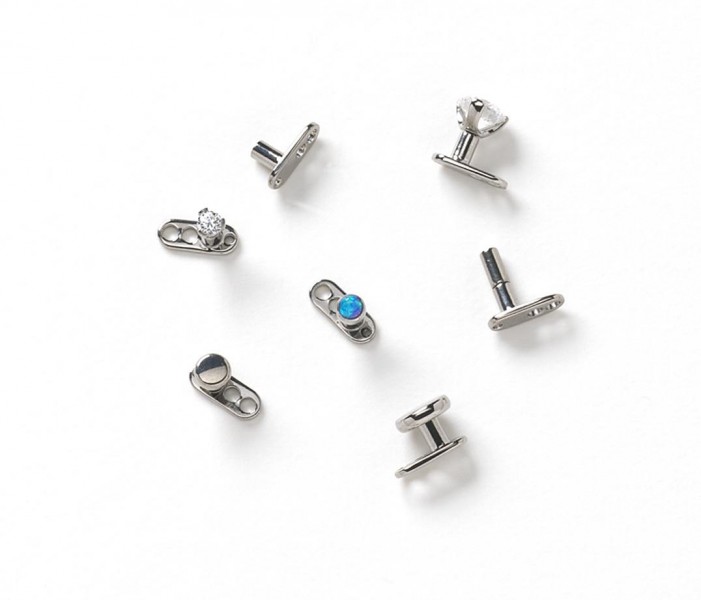 This relatively new technique with multiple names is becoming explosively popular. During the procedure, a tiny ornament is inserted into a single L-shaped opening that is formed in the tissue. The surface anchor is similar to surface piercing because it is done on flat areas, but placement options are greatly expanded all over the face, torso, and other locations of the body. Unlike the pairs always present in piercings, these have a single adornment per perforation. The embedded jewelry remains under the skin, while the visible threaded end can be changed. Multiple surface anchors are some- times arranged in patterns.
This relatively new technique with multiple names is becoming explosively popular. During the procedure, a tiny ornament is inserted into a single L-shaped opening that is formed in the tissue. The surface anchor is similar to surface piercing because it is done on flat areas, but placement options are greatly expanded all over the face, torso, and other locations of the body. Unlike the pairs always present in piercings, these have a single adornment per perforation. The embedded jewelry remains under the skin, while the visible threaded end can be changed. Multiple surface anchors are some- times arranged in patterns.
The procedure is performed with a piercing needle or a small dermal punch (see page 240) to make an opening. The jewelry is placed into a small pocket that is formed with the needle, a taper or similar tool, or the jewelry itself. Though surface anchors may bleed more than the average surface piercing, they appear to be easier to heal and not as subject to complications.
The mini jewelry used in this procedure has a flat plate (only about 1/4 inch long) that is inserted under the skin to affix it. The longer toe is placed in first, followed by the nublike heel that helps to hold the piece in the tissue. A short upright threaded post passes through the skin and extends to the surface where a gem, disc, or other threaded ornament screws onto the end of it. When inserted correctly, the jewelry appears to be glued onto the skin. Some of the plates are drilled with holes so the tissue grows into the base as it heals to secure the jewelry in place. Variations on the jewelry design are under investigation in the body art community. Healing time is reported to be one to three months.
Migration, rejection, scarring, and catching accidents, including traumatic removal, are risks, but the extent of scarring is apt to be limited due to the diminutive size of the wound. To remove it, the jewelry is firmly grasped, the tissue is held steady, and the ornament is forcibly taken from its pocket. If tissue has grown to the plate, a needle may be needed to free the piece. It appears they may be more likely to fall out than surface piercings, but they are less likely to grow out.
Single-point piercing (yet another name used for the process) is a relatively new and experimental modification, so there is no data on long-term successes or complications.

